An Arctic Adventure Among Gulls
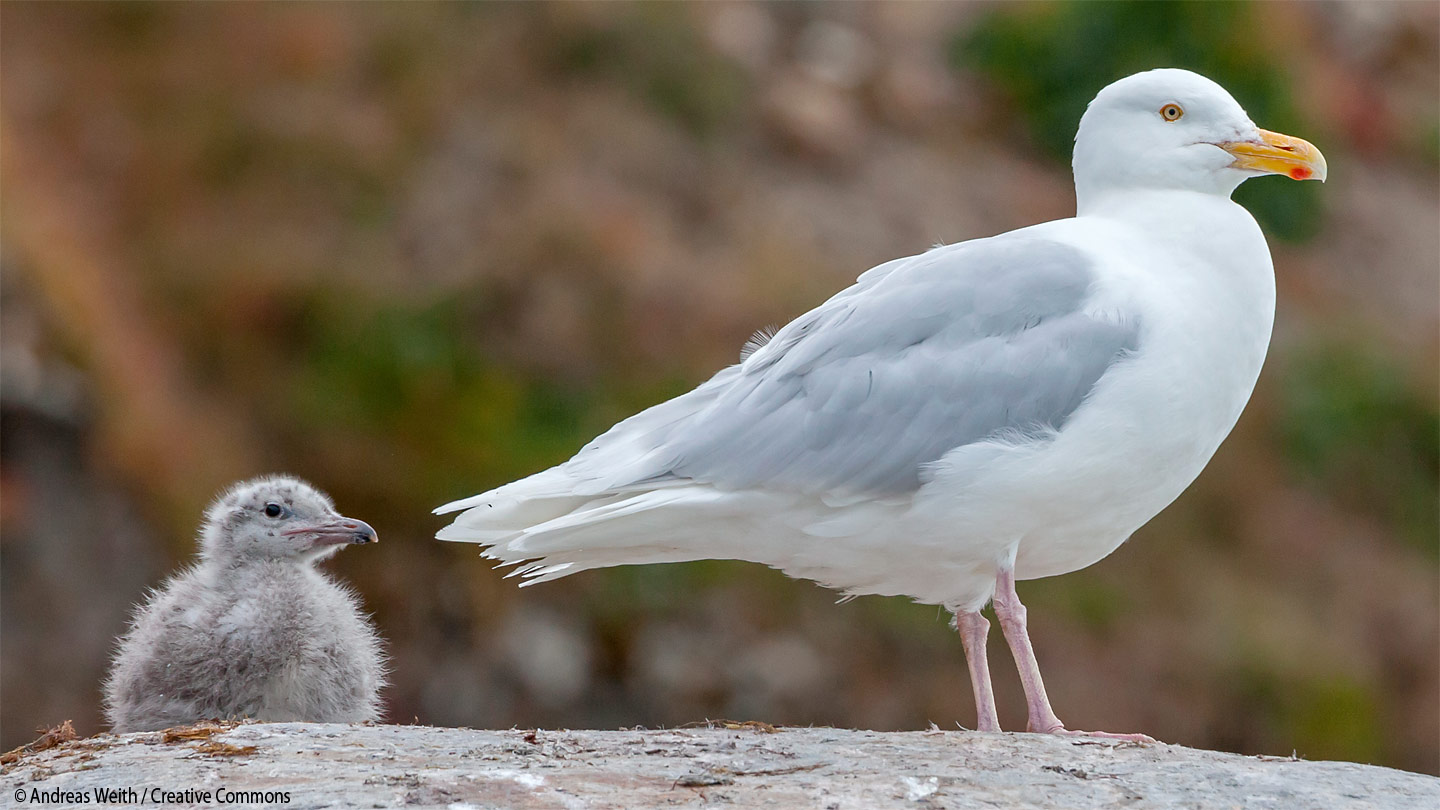
Adult Glaucous Gull and chick / Svalbard, Norway / © Andreas Weith / Creative Commons 4.0
IN THE SPRING OF 2016, somewhere in the vastness of the Arctic, perhaps on a cliff along the coast of Greenland, or maybe on a rocky island off the Yukon shore, but certainly not too far from the North Pole, a pair of Glaucous Gulls built a nest of sedge, moss and twigs. The female, like her mate, frosty gray and white, laid a clutch of eggs, speckled and spotted to resemble the tundra. And from one of those eggs hatched a gull that went on to make a remarkable journey … to a compost pile here in Vermont.
That an envoy from the Arctic might fly to Vermont, thousands of miles from its nest, is indeed amazing — but not that unusual. Snowy Owls are now visiting northern states this winter in good numbers. And gulls, more so than owls, are nothing if not wanderers. What’s remarkable, however, is that this particular Glaucous Gull, one of the northernmost breeding birds on the planet, may have made the rare and long journey to the compost heap not once — but twice.
The mystery begins on December 7, 2016, when this Glaucous Gull was about six months old and far away from home. Birdwatcher Zac Cota, checking out a mess of gulls at Grow Compost of Vermont, near the Winooski River in Moretown, spotted the young Glaucous Gull feeding among the piles of wood chips, yard waste and kitchen scraps. Zac got a few photos, as did other birdwatchers who visited with the gull throughout that winter — at least until February 11, 2017, when Chip Darmstadt was the last of us to have seen it. After that, the gull was cast to the winds of migration and to fate. The gull probably went north. Or perhaps it died. We just don’t know for sure.
And that might have been enough. These avian visits from the Arctic, however brief, are indeed rare and wonderful. After all, no polar bear will ever show up at Grow Compost. No Arctic fox will trot across a frozen Vermont dairy pasture, no matter how far south the polar vortex extends some winter. But the Snowy Owls and the Snow Buntings and a few other birds do indeed come to see us in the winter, bringing along echoes of distant lands we ourselves may never visit.[1] And when the frosty gulls show up, it is often the youngsters, in the first winter of their lives, perhaps possessing only the dumbness or exuberance of youth, making the trip south. Maybe even twice. (By the way, the good folks at Grow Compost have been incredibly welcoming to birdwatchers. So please do what you can to support his growing Vermont business.)
Now here in this post is where I stray into a lesson on gull identification and aging. But stick with me. It is essential to this mystery. And it’s something I taught on Thursday during a gull appreciation lecture at North Branch Nature Center here in Montpelier, which on a cold night drew 48 enlightened souls. Gulls are indeed so worthy.
As it turns out, some gulls, particularly young gulls, are relatively hard for birders to identify, which scares a lot of those birders, and which is too bad. The Glaucous Gull and its ilk, for example, take four years to go from chick to adult. And in each of those four years, the young gulls show two different plumages — basically summer and winter. So any of these four-year gulls, unlike a chickadee, for example, has eight or more distinct plumages throughout its life. Yes, it makes gull-watching a lifelong learning experience. But it also allows us to put an age on these distinctive younger gulls as they grow up.
Which is why I know the age of the Grow Compost gull. Its plumage matched what we call “first-cycle” — a gull in the first year of its life.[2] Glaucous Gulls generally breed in May or June, so the first-cycle gull at Grow Compost last December was about a half year old (we also call it “first-winter plumage” this time of year). Easy enough. The plumage you see in Zac’s photo (just above) — pale white with checked patterns of brown, a bicolored bill and dark eye — is classic for a first-cycle Glaucous Gull, no matter where it came from (they’re circumboreal, by the way). The gull pretty much looked the same all winter — at least until it was last seen by Chip in February of this year, when it was about eight months old, and then soon left us for who knows where. End of story. Or is it?
News arrived just this week of another Glaucous Gull at Grow Compost. Hmm. I should point out that Glaucous Gulls are indeed rare here in Vermont and in the lower 48 (plus, of course, Hawaii). Over the course of most winters, I might see anywhere from none to three or four Glaucous Gulls (and I purposely look for gulls each winter). So another Glaucous Gull at Grow Compost got me thinking out loud during my lecture on Thursday: Could this be the same Glaucous Gull?
We can begin to seek the answer to that question with a hypothesis: yes, this is indeed the same gull back for food scraps for another winter in Moretown. And like any good scientific hypothesis this one can be proven wrong — it is falsifiable: If this is the same Glaucous Gull, which we know hatched in spring of 2016, it should now be about 1.5 years old. A year older since last winter, it is now a second-cycle Glaucous Gull, entering the second winter of its life.
So to test my hypothesis, I’ll try to prove it wrong, which is often easy (and frankly what I would expect in this situation). To demonstrate that this in fact not the same Glaucous Gull, we once again turn to this new gull’s age. If this recently discovered gull is another first-cycle bird (six months old) or even a third- or fourth-cycle gull (at least 2.5 years old), it cannot not be same bird (unless it can alter the space-time continuum).
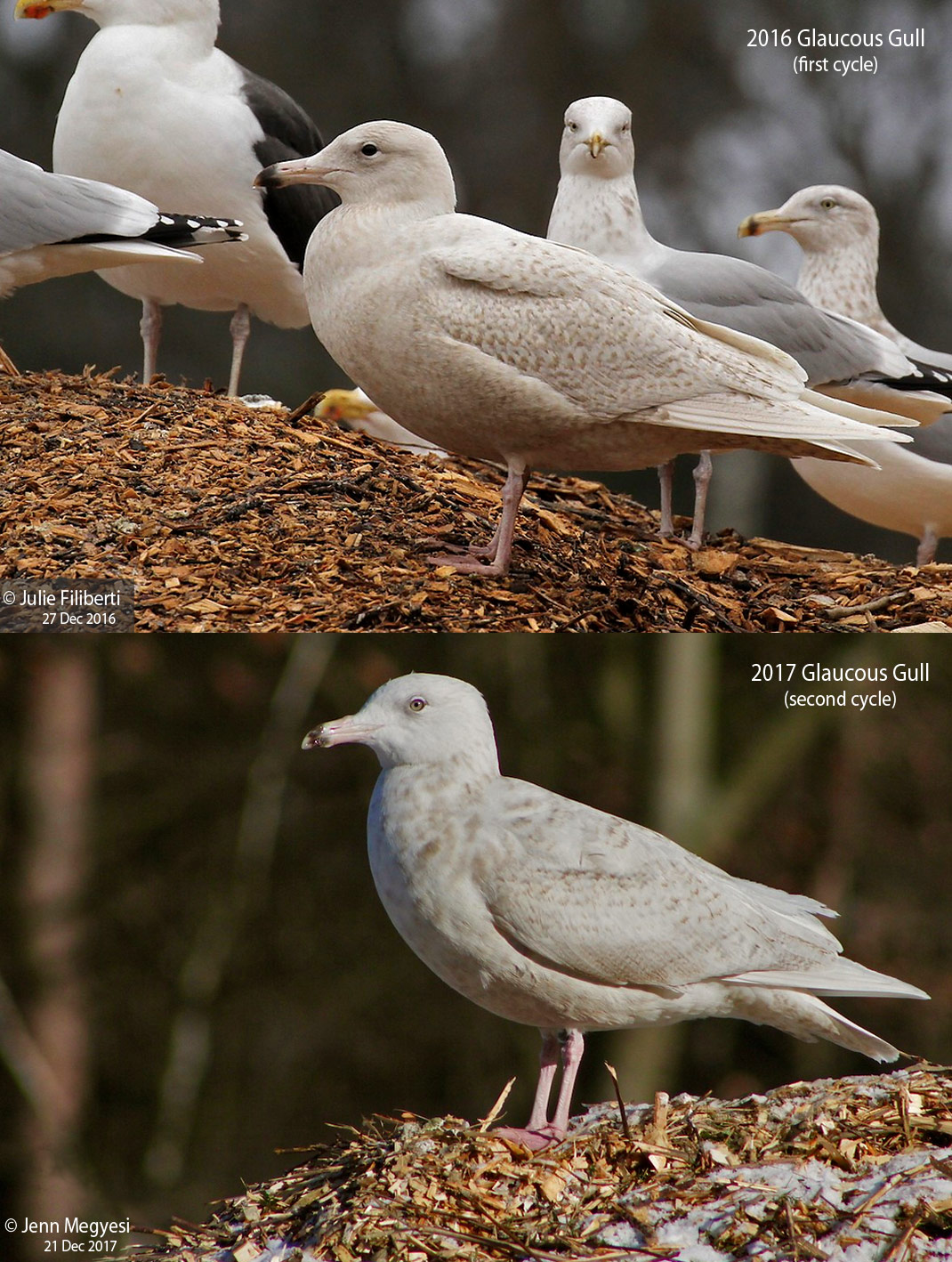 Jenn Megyesi can help. A skilled observer and farmer-biologist, Jenn captured Ring-billed Gulls near this site as a student researcher at the University of Vermont back in 1988. On Thursday, Jenn was back in Moretown to enjoy the gulls when she discovered, as Zac did a year ago, a Glaucous Gull at Grow Compost. She shot some nice photos. And if you compare Jen’s 2017 gull with the 2016 gull (in Julie Filiberti’s photo) here, you’ll see some subtle differences:
Jenn Megyesi can help. A skilled observer and farmer-biologist, Jenn captured Ring-billed Gulls near this site as a student researcher at the University of Vermont back in 1988. On Thursday, Jenn was back in Moretown to enjoy the gulls when she discovered, as Zac did a year ago, a Glaucous Gull at Grow Compost. She shot some nice photos. And if you compare Jen’s 2017 gull with the 2016 gull (in Julie Filiberti’s photo) here, you’ll see some subtle differences:
- Eye color: dark in 2016, yellow in 2017.
- Feather markings: fairly heavily and uniformly flecked in 2016; softer, more diffuse markings, with more clean gray feathers, in 2017.[3]
- Bill: stark bi-colored in 2016, bi-colored but showing a pale tip in 2017.
These differences point to one particular plumage for this winter’s gull: second-cycle Glaucous Gull. I have therefore failed to falsify my hypothesis. This gull Jenn photographed this week is the right age to be the same individual that visited Grow Compost last winter.
Can I prove that this is in fact the very same bird? I cannot. Not unless I had captured and marked it in some identifiable way last year. But with Glaucous Gulls so rare, and this bird the correct age and in the same location so far away from the Arctic, the coincidence would be hard to accept (although not out of the realm of the possible).
By the way, yes, these are indeed subtle plumage differences for some of you. Aging first- and second-cycle gulls can be fraught with doubt. Gull plumages are notoriously variable — they break lots of rules.[4] I might yet find a birder who would take issue with my determination that this is a second-cycle Glaucous Gull (but I suspect not).
So at least for now, my hypothesis holds. My suspicion is that the Grow Compost Glaucous Gull has indeed come back to visit us here in Vermont. And even if I’m wrong, well, two Glaucous Gulls made their way to the compost piles. No matter what its provenance, we can enjoy this winter’s Arctic visitor here in Vermont. And if in one a year from now, a third-winter Glaucous Gull shows up at Grow Compost, I will recall the name that ornithologists use for this species: Larus hyperboreus. Then I will thank Boreas, the Greek god of the north wind, who might have offered this gull a favorable tailwind on its long journey south to Vermont.
Or maybe even three tailwinds.
Addendum: As it turns out, we had two Arctic gulls at Grow Compost last winter — the Glaucous Gull and a first-cycle Iceland Gull. I’m getting reports of at least two Iceland Gull at Grow Compost, one of which is a first-cycle bird. We’re not yet sure about the second. So stay tuned for an update — this could get even more interesting.
Footnotes
[1] Regular readers of this blog or my other writings will recognize this theme (is it a meme?) about wild visitors from far afield. But I believe it bears repeating, lest we forget how wonderful and evocative the animals can be.
[2] These “cycles” have more to do with regular periods of feather replacement, or molt, than with the calendar year. To really know birds, you gotta know the molt.
[3] My own plumage analysis is more detailed than what I summarized above. Birders who know this stuff can check out the 2017 bird for its cleaner, greater primary coverts; more diffuse markings on the undertail coverts; and reduced markings on the head. To be sure, I’ve seen second-winter Glaucous Gulls paler and cleaner this this one, but this bird is clearly in the game for second cycle. The bill tip, by the way, on the first-cycle bird is a bit pale, which I don’t often see. But it’s so much more so on the second-cycle bird. It’s also hard to argue the eye color difference.
[4] For my determination on the second-cycle bird, I’m using the classic gull references, which I’ve listed below.
References
- Gulls: A Guide to Identification by P. J. Grant
- Gulls of North America, Europe, and Asia by Klaus Malling Olsen and Hans Larsson
- Gulls of the Americas by Steve N. G. Howell and Jon Dunn
- Birds of North America – Glaucous Gull. Weiser, Emily and H. Grant Gilchrist. 2012. Glaucous Gull (Larus hyperboreus), version 2.0. In The Birds of North America (P. G. Rodewald, editor). Cornell Lab of Ornithology, Ithaca, New York, USA. https://doi.org/10.2173/bna.573
Links
- Glaucous Gull images from Grow Compost, via the amazing Macaulay Library, which aggregates eBird photos.
- Glaucous Gull life history from the Audubon Guide to North American Birds.
- The incredible Anything Larus by Amar Ayyash.
Photos
For good measure, here are a couple flight shots (from Josh Lincoln) of the first-winter Glaucous Gull. I’ll turn this into a photo gallery once I receive more images.
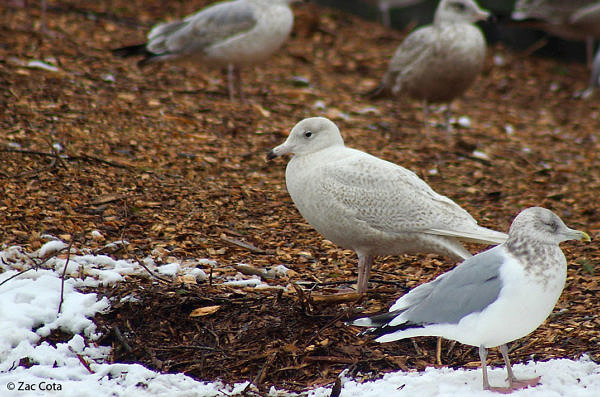
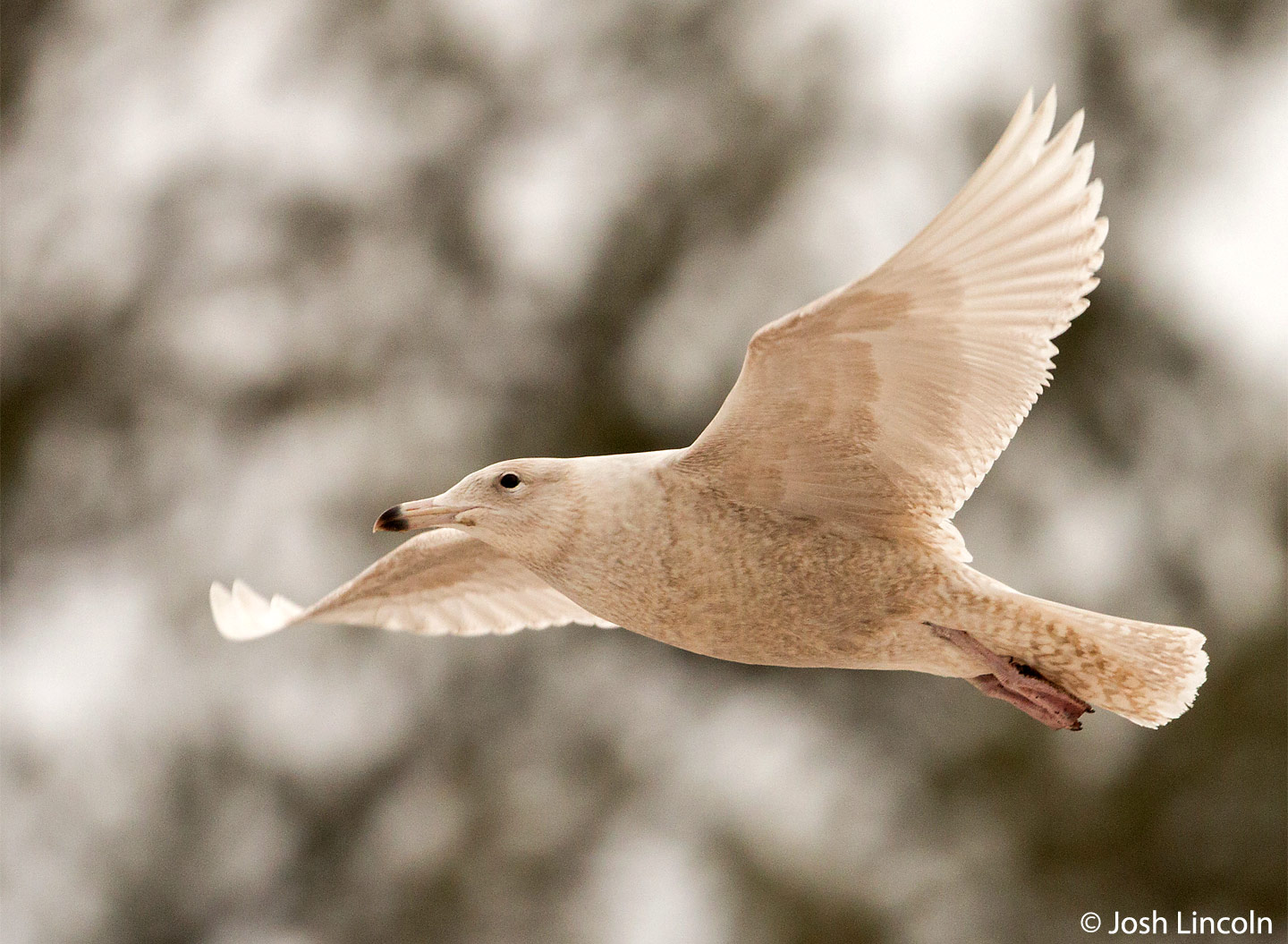
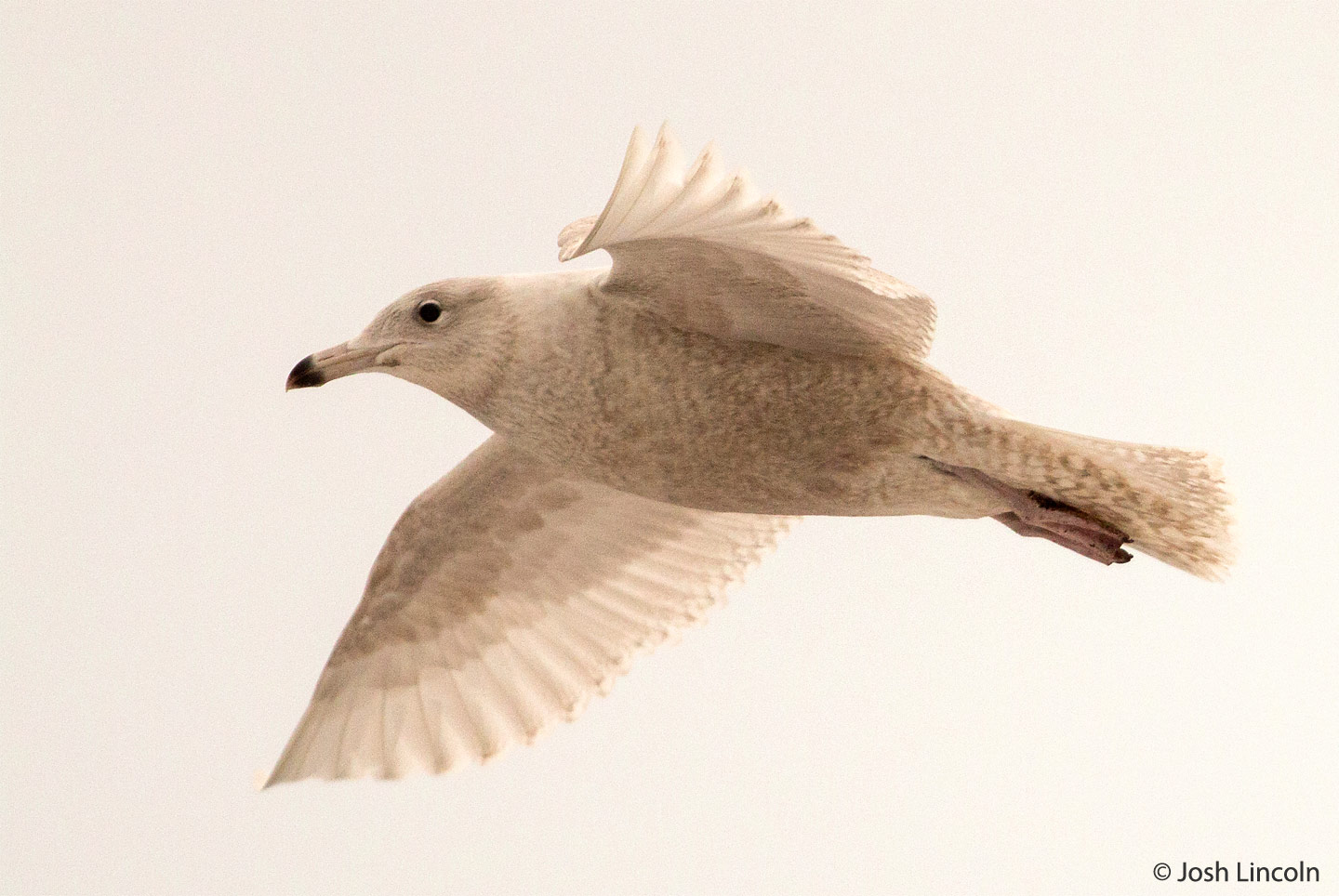

Fascinating! Loving The Auk paper. Thanks.
Thanks Bryan. The details of plumage amaze me. What a world we live in. Thanks for the explanation.
I suspect not, Shirley. Yes, it would indeed be interesting, but probably not worth the effort it would take to capture a gull and band it. Plus, it wouldn’t be part of some bigger research. I’ll bet there’s good data or literature on gull “migration.” I’ll poke around.
Thanks, Sarah. Nice to hear from you. I’m doing really well, feeling great. Actually, more writing has to do with more time around the holidays for me, I suspect. I hope to go back to not writing much (:-)) and being outside more by springtime!
Hi Bryan. I’m enjoying fruits of your enforced rehab period, which seems to include more writing.
I hope you are enjoying it, too. Good to have the benefit of your cogent story-telling on subjects of great interest.
Best of winter greetings to you and Ruth
Can this gull be banded while it’s here?